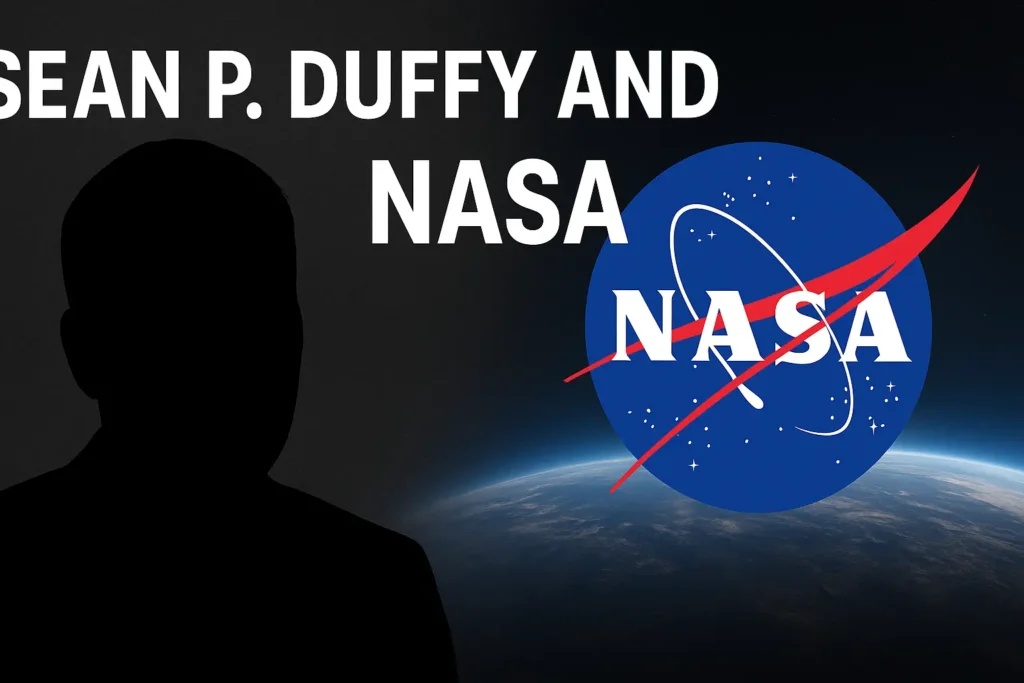Summary
Since his appointment as Acting Administrator of NASA in July 2025, Sean P. Duffy has initiated a sweeping redirection of the agency’s priorities — emphasizing human exploration of the Moon and Mars while reducing focus on Earth and climate science. The changes have prompted both technical and sociopolitical debate across the aerospace community, industry, and within NASA’s own workforce.
1. Who Is Sean P. Duffy?
Sean P. Duffy is a former U.S. Representative (2011–2019), attorney, and television commentator. In January 2025, he was appointed U.S. Secretary of Transportation. Six months later, on July 9, 2025, he assumed the additional role of Acting NASA Administrator.
The dual appointment—unusual in NASA’s history—placed the space agency under the direction of a cabinet official with limited prior experience in science or aerospace management. His professional background, however, reflects extensive experience in public communication and political administration.
“NASA will move from analysis to action,” Duffy said during his first town hall meeting. “Exploration will be our core mission again.”
2. Policy and Programmatic Actions
Shift in Strategic Focus
Within weeks of taking office, Duffy announced that NASA would pivot from Earth observation and climate science toward deep space exploration. His statements included a clear declaration that “all of the science we do will be directed toward exploration.”
This represents a significant rebalancing of NASA’s traditional dual mission: scientific understanding of Earth and the universe, and human exploration beyond Earth orbit.
Budget Realignment
The FY-2026 budget proposal released by the administration included approximately a 25% reduction in NASA’s Earth Science Division. Programs such as the Earth System Observatory, OCO-3, and PACE were flagged for either deferment or termination.
Meanwhile, funding for human spaceflight and exploration programs—particularly Artemis—received priority increases.
Lunar Program Recompete
In October 2025, NASA confirmed that it would reopen competition for the Artemis III lunar lander, previously awarded to SpaceX. Duffy said the decision was intended to “ensure resilience and competition.” The move has been welcomed by some industry players but criticized by others as potentially destabilizing the mission timeline.
3. Technical Implications
Earth Science
Technical analysts warn that reductions in Earth science funding could cause data continuity gaps in long-running satellite records that monitor atmospheric composition, carbon flux, ocean color, and cryospheric change. These datasets support both global research and operational climate models.
Experts note that once such time series are broken, rebuilding continuity can take decades. Partnerships with NOAA, ESA, and ISRO could mitigate the loss, but agency-level capacity remains central to mission integration and calibration.
Artemis and Human Spaceflight
By contrast, Duffy’s exploration agenda accelerates funding toward the Artemis program, aiming for a crewed lunar landing in the late 2020s.
Opening new competition for lander contracts could diversify the industrial base and stimulate innovation. However, procurement cycles and certification processes may delay the lunar landing schedule by 12–18 months, depending on how selection and testing proceed.
Safety and Oversight
Some NASA veterans have expressed concern that the agency’s safety culture—a legacy of Apollo and Shuttle tragedies—could erode under rhetoric that equates caution with delay. Duffy has stated that “sometimes safety becomes the enemy of progress,” sparking internal debate about risk management standards.
4. Workforce and Organizational Effects
In August 2025, over 600 current and former NASA employees signed the “Voyager Declaration,” a public letter expressing alarm over proposed cuts and the perceived politicization of agency priorities.
The declaration called for preservation of NASA’s scientific independence and safety-first ethos.
NASA’s public affairs office later affirmed that “safety-critical roles will remain fully supported.”
Still, morale surveys and anecdotal reports suggest growing uncertainty within Earth Science and Systems Engineering divisions.
5. Industry and Political Reactions
Contractor Landscape
Space industry observers note that Duffy’s open-bidding strategy for Artemis has increased competition among prime contractors, including SpaceX, Blue Origin, and Dynetics.
While competition could reduce costs long-term, abrupt contract changes risk supply chain discontinuities and interface compatibility issues within the Artemis program architecture.
Congressional Oversight
Congressional committees have begun reviewing NASA’s budget revisions, citing the need for continued Earth observation continuity and transparent procurement.
Lawmakers from both parties have expressed concern that long-standing climate missions might be prematurely canceled before alternative arrangements are secured.
Public Discourse
In media and social platforms, reactions reflect broader divisions over climate policy, scientific autonomy, and America’s leadership in space. Supporters frame Duffy’s approach as a return to NASA’s “original purpose” of exploration; critics view it as a politicization of science and a potential hollowing out of institutional expertise.
6. Technical and Institutional Outlook
| Domain | Primary Risk | Risk Level | Recovery Horizon |
|---|---|---|---|
| Earth Science Missions | Data continuity loss, workforce attrition | High | 5–8 years |
| Artemis Program | Procurement delays, schedule slippage | Moderate | 1–2 years |
| Institutional Health | Safety culture erosion, morale decline | Medium–High | 3–5 years |
Overall, NASA’s near-term technical capacity remains strong, but programmatic instability poses long-term challenges if current trends persist. Much depends on congressional appropriations and the balance of funding between exploration and science in FY-2026 and FY-2027.
7. Looking Ahead
Observers are watching several indicators closely:
- Final FY-2026 appropriations and NASA budget language
- The timeline for new Artemis lander awards
- Retention rates among key Earth Science personnel
- Continuity of data streams from OCO-3, PACE, and NISAR
- The frequency and independence of safety and readiness reviews
Editorial Note
This article is intended to provide a factual overview of policy changes, technical implications, and stakeholder reactions under Sean P. Duffy’s tenure as Acting Administrator of NASA.
SpaceInfo maintains an editorial policy of neutrality and transparency when reporting on ongoing institutional debates in space policy and science.



